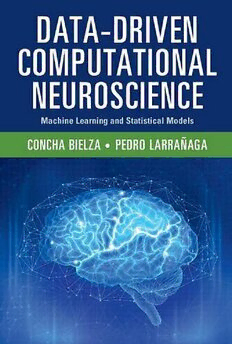Table Of ContentData-DrivenComputationalNeuroscience
Data-drivencomputationalneurosciencefacilitatesthetransformationofdataintoinsights
onthestructureandfunctionsofthebrain.Thisintroductionforresearchersandgraduate
studentsisthefirstin-depth,comprehensivetreatmentofstatisticalandmachinelearning
methods for neuroscience. The methods are demonstrated through case studies of real
problemstoempowerreaderstobuildtheirownsolutions.Thebookcoversawidevariety
of methods, including supervised classification with non-probabilistic models (nearest-
neighbors,classificationtrees,ruleinduction,artificialneuralnetworks,andsupportvec-
tor machines) and probabilistic models (discriminant analysis, logistic regression, and
Bayesian network classifiers), metaclassifiers, multidimensional classifiers, and feature
subsetselectionmethodsaswellasunsupervisedclassification.Otherpartsofthebookare
devotedtoassociationdiscoverywithprobabilisticgraphicalmodels(Bayesiannetworks
andMarkovnetworks)andspatialstatisticswithpointprocesses(completespatialrandom-
ness and cluster, regular, and Gibbs processes). Cellular, structural, functional, medical,
andbehavioralneurosciencelevelsareconsidered.
Concha Bielza is a professor in the Department of Artificial Intelligence at Universidad
Politécnica de Madrid. She has published more than 120 impact factor journal papers
and coauthored the book Industrial Applications of Machine Learning (2019). She was
awarded the2014UPM Research Prizeandreceived the2020MachineLearningAward
fromtheAmityUniversityinIndia.
PedroLarrañagaisaprofessorintheDepartmentofArtificialIntelligenceatUniversidad
PolitécnicadeMadrid.Hehaspublishedmorethan150journalpapersandcoauthoredthe
bookIndustrialApplicationsofMachineLearning(2019).HeisFellowoftheEuropean
Association for Artificial Intelligence and of Academia Europaea. He received the 2020
MachineLearningAwardfromtheAmityUniversityinIndia.
Data-Driven Computational
Neuroscience
Machine Learning and Statistical Models
CONCHA BIELZA
UniversidadPolitécnicadeMadrid
PEDRO LARRAÑAGA
UniversidadPolitécnicadeMadrid
UniversityPrintingHouse,CambridgeCB28BS,UnitedKingdom
OneLibertyPlaza,20thFloor,NewYork,NY10006,USA
477WilliamstownRoad,PortMelbourne,VIC3207,Australia
314–321,3rdFloor,Plot3,SplendorForum,JasolaDistrictCentre,NewDelhi–110025,India
79AnsonRoad,#06–04/06,Singapore079906
CambridgeUniversityPressispartoftheUniversityofCambridge.
ItfurtherstheUniversity’smissionbydisseminatingknowledgeinthepursuitof
education,learning,andresearchatthehighestinternationallevelsofexcellence.
www.cambridge.org
Informationonthistitle:www.cambridge.org/9781108493703
DOI:10.1017/9781108642989
©ConchaBielzaandPedroLarrañaga2021
Thispublicationisincopyright.Subjecttostatutoryexception
andtotheprovisionsofrelevantcollectivelicensingagreements,
noreproductionofanypartmaytakeplacewithoutthewritten
permissionofCambridgeUniversityPress.
Firstpublished2021
PrintedintheUnitedKingdombyTJBooksLimited,PadstowCornwall
AcataloguerecordforthispublicationisavailablefromtheBritishLibrary.
LibraryofCongressCataloging-in-PublicationData
Names:Bielza,Concha,author.|Larrañaga,Pedro,1958–author.
Title:Data-drivencomputationalneuroscience:machinelearningandstatistical
models/ConchaBielza,UniversidadPolitécnicadeMadrid,PedroLarrañaga,
UniversidadPolitécnicadeMadrid
Description:Cambridge,UnitedKingdom;NewYork,NY:CambridgeUniversityPress,
2020.|Includesbibliographicalreferencesandindex.
Identifiers:LCCN2019060117(print)|LCCN2019060118(ebook)|
ISBN9781108493703(hardback)|ISBN9781108642989(epub)
Subjects:LCSH:Neurosciences–Dataprocessing.|Neurosciences–Statisticalmethods.
Classification:LCCQP357.5.B542020(print)|LCCQP357.5(ebook)|DDC612.8–dc23
LCrecordavailableathttps://lccn.loc.gov/2019060117
LCebookrecordavailableathttps://lccn.loc.gov/2019060118
ISBN978-1-108-49370-3Hardback
CambridgeUniversityPresshasnoresponsibilityforthepersistenceoraccuracy
ofURLsforexternalorthird-partyinternetwebsitesreferredtointhispublication
anddoesnotguaranteethatanycontentonsuchwebsitesis,orwillremain,
accurateorappropriate.
TomymotherAurora,mysistersAurora,Marga,andSilvia,
andthememoryofmyfatherLuis
ConchaBielza
TomywifeMaría,mydaughtersNagoreandAna,andthememory
ofmyparentsBegoñaandMoisés
PedroLarrañaga
Contents
Preface pagexi
ListofAcronyms xv
PartI Introduction 1
1 ComputationalNeuroscience 3
1.1 TheMultilevelOrganizationoftheBrain 3
1.2 TheHumanBrain 6
1.3 BrainResearchInitiatives 8
1.4 Neurotechnologies 12
1.5 Data-DrivenComputationalNeuroscience 18
1.6 RealExamplesDiscussedinThisBook 30
PartII Statistics 51
2 ExploratoryDataAnalysis 53
2.1 DataTypes 53
2.2 UnivariateData 54
2.3 BivariateData 67
2.4 MultivariateData 70
2.5 ImputationofMissingData 87
2.6 VariableTransformation 88
2.7 BibliographicNotes 94
3 ProbabilityTheoryandRandomVariables 96
3.1 ProbabilityTheory 96
3.2 UnivariateDiscreteDistributions 100
3.3 UnivariateContinuousDistributions 106
3.4 MultivariateProbabilityDistributions 113
3.5 SimulatingRandomVariates 124
3.6 InformationTheory 136
3.7 BibliographicNotes 140
viii Contents
4 ProbabilisticInference 141
4.1 ParameterEstimation 141
4.2 HypothesisTests 162
4.3 BibliographicNotes 195
PartIII SupervisedClassification 199
5 PerformanceEvaluation 201
5.1 TheLearningProblem 202
5.2 PerformanceMeasures 204
5.3 PerformanceEstimation 211
5.4 StatisticalSignificanceTesting 216
5.5 ImbalancedDataSetsandAnomalyDetection 223
5.6 BibliographicNotes 224
6 FeatureSubsetSelection 226
6.1 OverviewofFeatureSubsetSelection 227
6.2 FilterApproaches 230
6.3 WrapperMethods 238
6.4 EmbeddedMethods 252
6.5 HybridFeatureSelection 254
6.6 FeatureSelectionStability 255
6.7 Example:GABAergicInterneuronNomenclature 256
6.8 BibliographicNotes 259
7 Non-probabilisticClassifiers 262
7.1 NearestNeighbors 262
7.2 ClassificationTrees 271
7.3 RuleInduction 286
7.4 ArtificialNeuralNetworks 291
7.5 SupportVectorMachines 300
7.6 BibliographicNotes 317
8 ProbabilisticClassifiers 320
8.1 BayesDecisionRule 321
8.2 DiscriminantAnalysis 325
8.3 LogisticRegression 332
8.4 BayesianNetworkClassifiers 347
8.5 BibliographicNotes 384
9 Metaclassifiers 387
9.1 MainIdeasonMetaclassifiers 387
9.2 CombiningtheOutputsofDifferentClassifiers 392
Contents ix
9.3 PopularMetaclassifiers 399
9.4 Example:InterneuronsversusPyramidalNeurons 410
9.5 Example:InterneuronsversusPyramidalNeurons;Comparison
ofAllClassifiers 411
9.6 BibliographicNotes 413
10 MultidimensionalClassifiers 415
10.1 Multi-labelandMultidimensionalClassification 415
10.2 EquivalentNotationsforMulti-labelClassification 417
10.3 PerformanceEvaluationMeasures 418
10.4 LearningMethods 421
10.5 Example:QualityofLifeinParkinson’sDisease 432
10.6 BibliographicNotes 434
PartIV UnsupervisedClassification 435
11 Non-probabilisticClustering 437
11.1 Similarity/DissimilaritybetweenObjects 437
11.2 HierarchicalClustering 439
11.3 PartitionalClustering 442
11.4 ChoiceoftheNumberofClusters 456
11.5 SubspaceClustering 458
11.6 ClusterEnsembles 460
11.7 EvaluationCriteria 463
11.8 Example:DendriticSpines 465
11.9 BibliographicNotes 467
12 ProbabilisticClustering 469
12.1 TheExpectation-MaximizationAlgorithm 470
12.2 Finite-MixtureModelsforClustering 474
12.3 ClusteringwithBayesianNetworks 478
12.4 Example:DendriticSpines 484
12.5 BibliographicNotes 485
PartV ProbabilisticGraphicalModels 487
13 BayesianNetworks 489
13.1 BasicsofBayesianNetworks 490
13.2 InferenceinBayesianNetworks 503
13.3 LearningBayesianNetworksfromData 520
13.4 DynamicBayesianNetworks 537
13.5 Example:BasalDendriticTrees 539
13.6 BibliographicNotes 543

